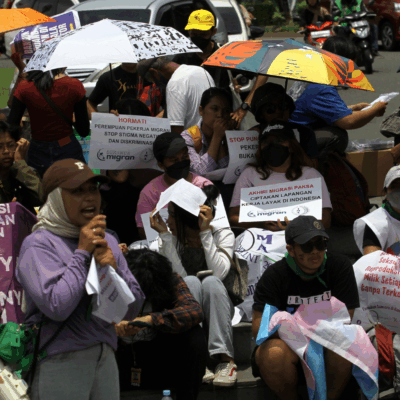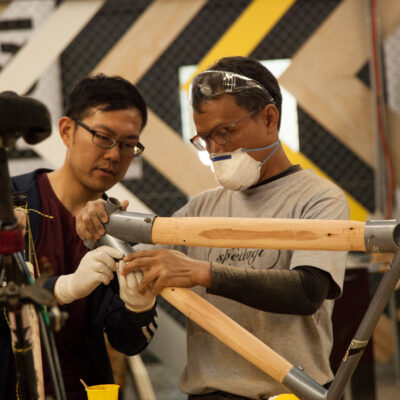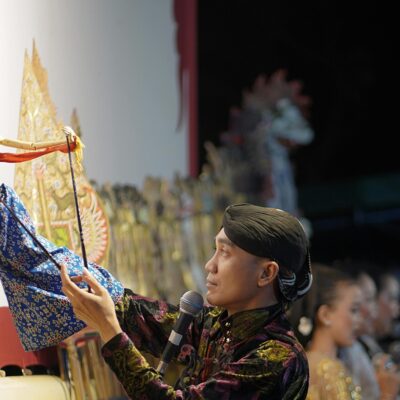The Baduy are an Indigenous community living in Kanekes village in the mountains of Banten province, some 100 kilometres southwest of the Indonesian capital, Jakarta. The Kanekes area covers some 5,000 hectares with a population of about 12,000 people.
Linguistically and culturally, they are related to the wider Sundanese population who live across much of western Java. The Baduy secluded themselves in the 16th century, rejecting increasing foreign influences—including Islam and the growing presence of Europeans—in order to preserve what they viewed as their authentic core values, including adherence to the social structures, agricultural techniques and guardianship of their sacred land as dictated by their ancestors. In recent years, the community has had increasing contact with the outside world, largely through tourism and growing integration with wider contemporary Indonesian society through participation in Indonesian government initiatives.
These rapidly evolving social and economic circumstances mean that Baduy culture and language are currently changing more quickly than at any time in the past.
Baduy society is organised between so-called inner and outer communities. The inner Baduy live in three hamlets where they maintain their older agricultural lifestyle through very disciplined social structures and spiritual practices. Visitors are limited to Indonesians, who can only stay for brief periods. To the north and west are 64 other hamlets collectively referred to as outer Baduy, where the social structure is more accommodating, and visitors of diverse backgrounds can remain for longer periods. In both the inner and the outer areas, there is a prohibition on the use of technology that is considered antithetical to traditional Baduy culture, including all electrical equipment and electronic devises, any mechanical means of transportation and various modern commercial products. These restrictions are much stronger for the inner Buday than those in the outer areas, but many Baduy people now regularly go to nearby non-Baduy areas and use mobile phones and other devices.
Despite this social, cultural and technological separation, it would be a mistake to romantically characterise the Baduy as somehow “untouched” by the outside world as some commentators have done. The Baduy have always been keenly aware of the surrounding cultural and political context in which they are embedded. Many Baduy people travel outside Kanekes and they have always worked to find ways to maintain their cultural identity while navigating interactions with the changing social and technological circumstances around them.
Language endangerment
While the Sundanese language is not currently endangered, the Baduy variety is undergoing change and potential loss of its unique characteristics as the community becomes more open to the outside world.
In the context of Indonesia, many regional languages are under threat due to a number of historic and contemporary reasons, including increased use of the national language, Indonesian, large scale internal migration and mass communication. These can restrict opportunities for the natural transmission of local languages from one generation to the next. This often goes unnoticed in communities during early stages and when the potential loss of a language becomes readily apparent there is often a strong sense of urgency in the community to revitalise and maintain their language and associated cultural heritage.
Language documentation
We have been involved in a project to document the Baudy language—Kurniawan as one of the lead investigators in a research team from Universitas Pendidikan Indonesia (UPI) in Bandung and Ewing as an outside consultant.
Language documentation generally involves community members and academics working together to record language use in a range of contexts and preparing these recordings for archiving and dissemination for use by the local community and researchers. This subfield of linguistics has developed over recent decades as awareness of language endangerment and associated threats to linguistic diversity and human rights have grown across the world.
The Baduy have long been aware of outside pressures on their culture and society but there has been less consciousness of changes to their language. It is often the case with language use among minority and marginalised communities that people are not cognisant of or concerned about language shift in the early stages and only become aware it once dramatic changes have taken place and the prospect of losing a key aspect of cultural identity becomes very real. One of the goals of working with communities on language documentation is to raise of awareness of language shift so that communities can make informed decisions about whether and how they may wish to work towards language maintenance.
Language shift
The researchers from UPI have observed language shift, especially among younger speakers and in the outer Baduy area, where there is increasing contact with non-Baduy people through tourism, contact with government administrations and an increased presence of shops and vendors. People in the outer area have access to more varied repertoires of language, including different varieties of Sundanese, the national language Indonesian, as well as some foreign languages such as English, Korean and Arabic.
Exposure to different language varieties is related to different domains of language use. In the inner Baduy hamlets, all interactions are still in Baduy Sundanese, whether in the home, working in the fields or in public contexts. For those in the outer Baduy area, the domains of Sundanese use are shrinking, with Indonesian taking over more outward facing social situations, similar to the situation with other regional languages across the archipelago. Additionally, the Sundanese used by members of the Baduy community is shifting to be more like mainstream Sundanese. Even among the inner Baduy, those who interact with outsiders and speak on behalf of the Baduy in relation to wider Indonesian society, will tend to speak “the way we do” according to one researcher, meaning with mainstream Sundanese mixed with Indonesian. This can be seen in the careful way these Baduy speakers construct their utterances to self-correct if they perceive they have used a word that is common among the Baduy but which may be considered impolite in mainstream society. Baduy people with less experience interacting with outsiders use much more distinctively Baduy language with less accommodation of other languages.
Due to their long seclusion, the language of the Baduy can sound archaic to speakers of modern Sundanese. There are many vocabulary differences as well as some grammatical variation, with the Baduy using linguistic items no longer used by mainstream speakers and contemporary innovations in standard Sundanese not adopted by the Baduy. What stands out most for modern Sundanese speakers, is that the Baduy have never adopted the intricate speech levels found in contemporary mainstream Sundanese, and also found in other languages in the region, such as Javanese and Balinese. These speech levels mark status relationships between speakers through grammatical and lexical choices and include a range of styles from respectful to coarse. Speech levels are thought to have developed into their current complex form among the Javanese in the 17th century but were only introduced into Sundanese in the 19th century, and were never adopted by the Baduy, who find the hierarchical foundation of the system at odds with their egalitarian social structure. Because of this, language that is simply normal for the Baduy can be interpreted as rude and unrefined by outsiders, thus giving rise to misunderstandings and negative judgements when their language is evaluated by the norms of standard Sundanese. Such negative judgements from more powerful outsiders can induce Baduy speakers (even unconsciously) to alter how they communicate, which in turn can cause further language shift throughout the community.
Collaboration: challenges and successes
Baduy speakers recognise that some of the structures and vocabulary they use are not forms that are common outside their community and tend to avoid these when speaking to outsiders. While this kind of accommodation is common practice among all speech communities, it can affect recordings when those documenting the language are from outside the community. The UPI team made assurances that they wanted to hear and record the language as it is used within the community, but many of the distinctive forms of Baduy were not originally encountered by the team. Fortuitously this changed when one of the team’s students stayed in the outer Baduy region for several months to study traditional musical practices. During that time, people became used to his presence and ceased changing their speech for him, so aspects of Baduy language previously unrecorded were revealed.
As academic researchers, it is important to be mindful of developing respectful relationships with communities. The Baduy community has had past misunderstandings with other researchers including misrepresentations in scholarly literature, and there was not a high level of trust when our research project began. Additionally, early outreach between UPI and the Baduy community involved data collection which was originally more motivated by theoretical linguistic concerns. This focused on eliciting vocabulary and sentence structures that could be used for specific analytical goals but was not seen as beneficial by the Baduy community themselves. Nonetheless, we regarded this early stage as successful at assembling data that included word lists, example sentences and narratives and developing a small dictionary with a collection of stories. As time went one, the UPI team was able to recalibrate their approach, working much more collaboratively with the community to achieve goals that were considered beneficial by the community and which in turn expanded the range of documentation outputs from the project.
In this way a much deeper level of trust was developed which meant there was greater engagement by the community in the project, which in turn yielded much richer results. This came about through sociable interaction after recording sessions, when there were lots of questions about the project and its goals and the benefits for the community. We also shifted our approach away from eliciting certain types of speech, towards encouraging participants to speak much more freely on any topic of interest. Crucially, once people viewed the videos after recording, they became much more interested in the project. In particular, the older generation watched how younger members of society became actively engaged with the recordings and understood their potential as a means of education for the next generation. This encouraged the older participants to open up and provide personal reflections and much more detailed discussions for the recordings, because they had a sense of the positive impact these recordings could have on younger people in their own communities.
These experiences also helped develop a sense of urgency among the elders as they realised what younger members of their community might not know and thus the scale of the potential loss of heritage. It also gave them a sense of how these materials could be shared with the wider society. This resulted in more interest from more people to participate in the documentation process. Key to this was embracing the benefits of documentation, both in terms of materials available to the community and the way the Baduy can have control over how they are portrayed to the outside world.
Generally, researchers cannot stay long in the Baduy area, and all our recording sessions needed to take place outside of the Baduy hamlets, where electronic equipment was allowed. This made the recording sessions somewhat unnatural. Language documentation projects usually aim to record a very wide range of social situations and contexts of language use, but the restrictions among the Baudy limited the kinds of events and interactions that could be recorded. Also, language maintenance and revitalisation work regularly relies on means of engagement that we take for granted in the 21st century, such as activities in schools, use of social media and smartphone apps, and other technologies. But many of these activities are still forbidden by the Baduy community within their geographic borders and Baduy children do not receive formal education through the Indonesian education system, so other means of disseminating documentation need to be found. One of our future goals is working with the community to identify additional culturally appropriate ways of documenting language use, such as discussions (rather than just monologues) and demonstrations of traditional skills, and making this documentation available to aid in the continuity and transmission of the language.
Possible future directions
One aim is the creation of books, video and audio recordings, and other products, geared towards different age groups, using the Baduy language and showcasing important aspects of Baduy culture. Although the Baduy historically have not been literate due to eschewing formal education, younger people have some reading skills through constant contact with the outside society. Means of disseminating such products depends on changing circumstances. There was a Baduy cultural centre that had been set up just outside the restricted Baduy area, but this has not been successful due to changing government support. Then, in the aftermath of a fire, a new village was built with government funding near the Baduy, allowing much easier access to the Baduy area for outsiders. This new village has modern facilities such as a medical clinic and shops. Children from Baduy like to go there to hang out and watch TV. On the one hand, this can be seen as going against the Baduy ethic, for example exposing young people to part of outside culture that some regard as having little value, such as Indonesian soap operas. On the other hand, seeing young people’s engagement with video, the UPI research team are working with the community to make animated videos in the Baduy language on relevant topics such as folk tales and explanations of social customs. The goal is to transform the experiences and knowledge of elders documented through the project into media that will appeal to younger people.
The Indonesian government recognises designated Indigenous communities (Masyarakat Adat) across Indonesia. There are several of these adat communities across the Sundanese cultural region of western Java, with each such village having its own customs, political structures and ways of engaging with modern society. But the Baduy stand out among these for their strict adherence to older traditions. For example, many of these other communities have embraced electronic media, with members opening Instagram accounts to promote their cultural identity to the wider world. To do so they use a lot of Indonesian and English. Such activities are still limited among the Baduy due to eschewing the use of electronic devices within their home areas. Nonetheless, such activities were increasing under their previous village leader, who had relaxed constraints on the ownership of mobile phones, motorcycles and so forth. Even if they could not bring them into the Baduy region, they were allowed to use them in other areas. However, recent changes in village leadership have precipitated moves towards a more conservative approach. This includes consideration of cutting links to government, such as the official designation of being an Indigenous community, which some feel have compromised Baduy integrity due to the administrative obligations it entails.
Some Baduy people see a connection between the influx of outsiders and a shift towards greater use of the Indonesian language and wish to return to the kind of self-reliance they historically maintained. But there is also the sense in the community that their traditional subsistence lifestyle is no longer sustainable due to encroachment on their environment and resources. They feel they need to find other ways to survive, which means growing engagement with the wider Indonesian economy.
Greater visibility means both an influx of outside influences which can dilute cultural integrity, but it also means greater access to resources to help with maintenance programs to counter the effects of such influences. The Baduy cannot be romanticised as an ‘untouched’ people kept as a kind of museum piece. Nor would it be ethical to forcibly integrate them into the modern nation state of Indonesia. This is a conundrum faced by many Indigenous communities who see that total isolation is not a realistic possibility. This is something that the UPI research team is keen to help with by providing the means for documentation and the production of resources like those mentioned above that the Baduy community would not have access to on their own, while at the same time recognising that decisions and actions regarding possible pathways forward remain with the Baduy themselves.
Authors: Prof Eri Kurniawan and A/Prof Michael Ewing.
Image: A Baduy village in West Java. Credit: Henry Sudarman/Flickr.




